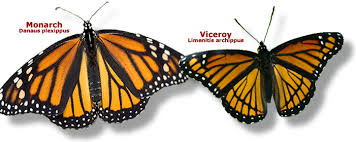How does natural selection result in the Viceroy butterfly bearing a close but superficial resemblance to the Monarch butterfly?
1 Answer
Viceroy butterfly is a mimic of Monarch Butterfly, which could be termed a model. Monarchs are slightly larger and distasteful for birds feeding on them. They are migratory and spend the winter in Mexico or California, but travels north towards Canada in warmer temperatures.

( )
)
Evolution of viceroy butterfly resembling monarch butterfly in appearance and in same geographical areas of North American continent could be termed as an example of mimicry and co-evolution.
Obviously, viceroy derives huge benefit by becoming the mimic of distateful monarch . Birds in the area have rejected viceroy types as well from the list of insects on which they can feast, along with monarchs.
So, we may say that by mimicking a distasteful butterfly, few viceroy butterflies in the population initially achieved anti-predator adaptation probably millions of years ago. Predators avoid monarch, and they mistakenly avoid viceroys for being similar in appearance. So mimics survived and flourished continuously.
Nature has selected the adaptive character of resemblance in viceroys as it helps them to survive better. Eventually viceroys evolved as a successful species in the area. Birds do not eat viceroys though these are palatable.
Please note, that a mimic (in this case viceroy butterfly) can derive advantage of its anti-predator adaptation only when it is outnumbered by the model (monarch butterfly) in the area.
